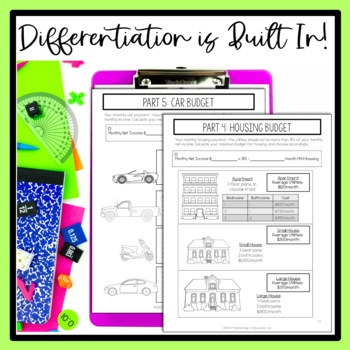Project Based Learning: Create a Personal Budget 6th Grade Math
- PDF
What educators are saying
Description
Project based learning for 6th grade math skills is awesome! Teach your students math skills and financial literacy through this project-based learning activity. Your students will practice decimal operations (money), work with percentages, and create scatter plots. Challenge activities allow for it to be used in 6th grade as well. It includes a teacher guide walking you through each step.
Your students will get their first peek at the process of creating a budget! Kids love having choices, and this project gives them the choices they want! Throughout this project, they get to choose their career, car, and house. Their choices may be limited depending on the salary they get with their career. During this structured PBL, kids will practice percentages and decimal operations (multiplication, division, addition, and subtraction), along with using critical thinking skills.
This is the 6th grade version of my BEST SELLING Project-Based Learning activity! Teach your students real life math skills using this high-interest PBL, while applying the Common Core (Or Other State) Standards they've learned! Your students will begin thinking about what career path they want to take, and will look at real life data on average salary, housing, food, and transportation costs. Supplementary articles on personal finance and functional text may be brought into this lesson to connect with Reading standards.
All of my PBLs include e-mail support. Check the feedback below to see what it's all about!
***************************************************************************
Other Project-based Learning Activities
★ Click here to see other 6th grade PBLs
★ Find the 5th grade version of this project
Need help implementing PBL or just want to join other PBL-lovers? Get every grade 3-6 project-based learning in my store (including future ones) and access to a private Facebook support group.
→ → → Join the Project-based Learning Club here!
Want to learn more about how to plan and implement project based learning? Take the online training course for comprehensive training videos and resources for the entire process!
→ → → Take the Project Based Learning Training Course!
***************************************************************************
Customer Tips:
How to get TPT credit to use on future purchases:
• Please go to your My Purchases page after you log in. Beside each purchase see a Provide Feedback button. Simply click it and you will be taken to a page where you can give a quick rating and leave a short comment for the product. Each time you give feedback, TPT gives you feedback credits that you use to lower the cost of your future purchases. I value your feedback greatly as it helps me determine which products are most valuable for your classroom so I can create more for you.
Be the first to know about my new discounts, freebies and products:
• Look for the green star next to my store logo and click it to become a follower.
*****************************************************************************





